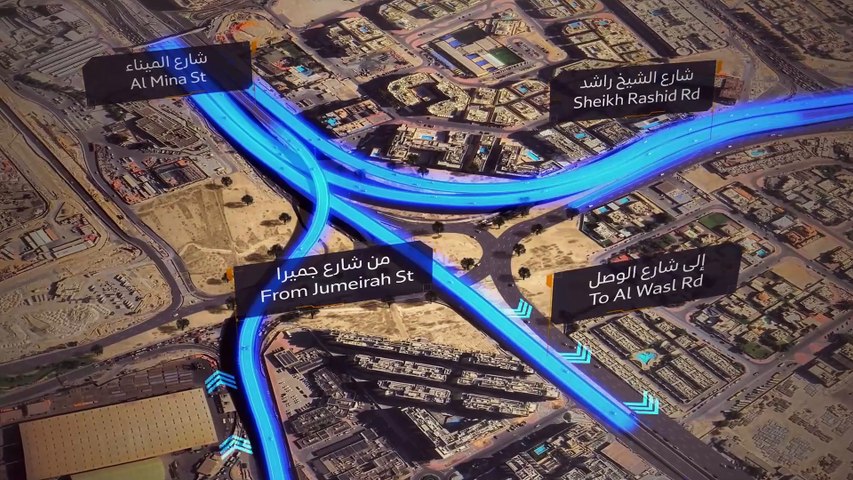Dubai never stops building, and this time, it’s all about moving people faster and smarter. The Al Shindagha Corridor Project, recently completed by the Roads and Transport Authority (RTA), is a game-changer for traffic flow in one of the city’s busiest zones. If you’ve ever been stuck in traffic from Al Garhoud to Port Rashid, you know how painful that commute used to be. Now? You can cruise it in just 12 minutes.
Project Overview
A Vision Years in the Making
The Al Shindagha Corridor wasn’t just a spontaneous infrastructure upgrade — it’s been in the pipeline as part of a strategic plan to ease congestion and accommodate Dubai’s explosive urban growth. Stretching over 13 km, this corridor links the north and south of the city, connecting older districts like Deira to newer developments like Dubai Islands.
Why It Matters
Dubai’s population is booming, and tourism is always on the rise. That means more cars, more movement, and the need for smarter road systems. The RTA took on this project with one goal: make life easier for more than a million residents and countless visitors.
Key Achievements of the Project

Travel Time Slashed from 80 to 12 Minutes
Yes, you read that right. What used to take over an hour now takes just 12 minutes. Whether you’re heading to work, visiting family, or catching a ship at Port Rashid, this project has turned what was once a hassle into a breeze.
From Bottlenecks to Breakthroughs
Traffic bottlenecks? A thing of the past. The corridor has transformed outdated junctions and intersections into a fluid network that can handle up to 24,000 vehicles per hour — that’s nearly quadruple the previous capacity.
A Boost to the Economy
It’s not just about convenience. The economic impact of cutting travel time, reducing fuel use, and improving logistics efficiency is projected to save Dubai a whopping AED 45 billion over 20 years.
Major Infrastructure Enhancements
Sheikh Rashid Road & Al Mina Street Intersection
This area got a serious facelift. Five new bridges now span 3.1 km, designed to support 19,400 vehicles every hour. And for pedestrians? Two new bridges ensure safer crossings without disrupting the flow of traffic.
Falcon Intersection: A Traffic Engineering Masterpiece
Located at the intersection of Khalid Bin Al Waleed Road and Al Mina Street, the Falcon Intersection is built to handle a staggering 28,800 vehicles per hour. It includes:
- Two six-lane bridges on Al Khaleej Street (24,000 vehicles/hr)
- A one-lane right-turn bridge (1,600 vehicles/hr)
- A two-lane tunnel for left turns (3,200 vehicles/hr)
Al Khaleej Street Tunnel: A Work in Progress
Currently 30% complete, this tunnel will stretch 1,650 meters with three lanes in each direction. Once done, it’ll support 12,000 vehicles per hour and serve as a key connector for Deira, Dubai Islands, and Abu Hail.
The Infinity Bridge: A Marvel of Design and Utility
The crown jewel of this corridor is the iconic Infinity Bridge. Besides its eye-catching design — shaped like the infinity symbol — it’s all about function.
Technical Brilliance
- 12 lanes: Six in each direction
- 3-meter-wide cycling track
- Handles 24,000 vehicles per hour
- 75-meter-wide marine navigation channel
It’s not just a bridge; it’s a lifeline for both land and marine traffic.
Integration with Dubai’s Urban Master Plan 2040
This isn’t just about today. The corridor is a foundational part of Dubai’s 2040 vision, which focuses on sustainability, efficient mobility, and smart infrastructure. By 2030, travel time is expected to drop further, ensuring Dubai stays ahead of the urban development curve.
Impact on Key Areas
Port Rashid and Dubai Waterfront
Easier access to the port means faster logistics, better cruise tourism infrastructure, and boosted trade capabilities.
Jumeirah and Deira Reconnected
What used to be a sluggish journey across old bridges is now a smooth drive that brings neighborhoods closer together, promoting local business and community ties.
Community and Environmental Considerations
The project didn’t ignore people on foot or the planet. With pedestrian bridges, improved sidewalks, and smart lighting systems, safety and environmental responsibility were top priorities.
What’s Next?
The Al Khaleej Tunnel is on the way, and that’s not all. Dubai is looking at smart traffic systems, AI-powered route management, and more intelligent infrastructure to keep the city moving.
Conclusion
Dubai has always been a city of ambition, and the Al Shindagha Corridor Project is proof that it delivers. From dramatically reduced commute times to futuristic urban planning, this corridor is more than just a road — it’s a symbol of progress. Whether you’re a local resident, business owner, or visitor, the benefits are clear. This is Dubai, moving at the speed of tomorrow.
FAQs
1. How does the project affect daily commuters in Dubai?
It dramatically reduces travel time from 80 minutes to just 12 minutes, making daily commutes faster, easier, and less stressful.
2. Is the Infinity Bridge open to cyclists?
Yes, there’s a dedicated 3-meter-wide cycling track, making it friendly for both motorists and cyclists.
3. What’s the timeline for completing the Al Khaleej Tunnel?
The tunnel is currently 30% complete and is expected to be finalized as part of future corridor expansions.
4. How will the corridor affect marine traffic?
The Infinity Bridge includes a 75-meter-wide channel to ensure uninterrupted marine movement, especially near Port Rashid.
5. How does this fit into Dubai’s 2040 Urban Master Plan?
It supports the plan’s vision of smart, sustainable, and high-capacity transportation systems to accommodate the city’s growing population and urban needs.




